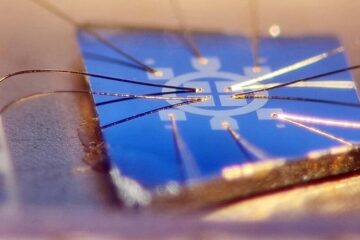John Rogers receives $500,000 Lemelson-MIT Prize

Rogers will accept the $500,000 prize – one of the world’s largest single cash prizes for invention – and present his accomplishments to the public at a ceremony during the Lemelson-MIT program’s annual EurekaFest at the Massachusetts Institute of Technology June 15-18.
Renowned for his recent pioneering work with semiconductor materials and flexible, stretchable electronics, Rogers applies his expertise to devise technology solutions across such broad fields as solar power, biointegrated electronics, sensing, thin film metrology and fiber optics.
Rogers combines soft, stretchable materials with micro-and nanoscale electronic components to create classes of devices with a wide range of practical applications. His recent work has produced devices from tiny eye-like cameras to less-invasive surgical tools to biocompatible sensor arrays.
Ilesanmi Adesida, the dean of the College of Engineering at Illinois, cited Rogers’ ability to span across incongruent fields of work as a reason for his success.
“Rogers can move effortlessly from science to technology and to practical applications with a unique vision for the translation of science to products,” Adesida said.
“His work exemplifies how to effectively bolster sciences and technology so the United States can successfully compete and prosper in the global community of the 21st century.”
Not content to merely invent, Rogers also is an entrepreneur. He is co-founder and director of the device companies MC10 Inc. and Semprius Inc., both of which work to apply and commercialize technology he has invented. Previously, he co-founded a successful company, Active Impulse Systems Inc., that commercialized his picosecond laser techniques for analysis of thin films used in the semiconductor industry and was later acquired by a large company.
The son of a physicist and a poet, Rogers earned his doctorate in physical chemistry from MIT in 1995. Since joining the Illinois faculty in January 2003, he has distinguished himself as a mentor, encouraging his large group of students to collaboration, perseverance and innovation. He is a professor of materials science and engineering, of chemistry, of mechanical science and engineering, of bioengineering and of electrical and computer engineering.
Rogers, who is affiliated with the U. of I. Beckman Institute for Advanced Science and Technology, has written more than 300 published papers and holds more than 80 patents. Among his many honors, he has been elected to the National Academy of Engineering, awarded a MacArthur fellowship, and named a fellow of the Institute for Electrical and Electronics Engineers, the American Physical Society, the Materials Research Society, and the American Association for the Advancement of Science.
Jerome H. Lemelson, one of America’s most prolific inventors, and his wife, Dorothy, founded the Lemelson-MIT Program at MIT in 1994. It is funded by The Lemelson Foundation, a private philanthropy that sparks, sustains and celebrates innovation and the inventive spirit. It supports projects in the U.S. and developing countries that nurture innovators and unleash invention to advance economic, social and environmentally sustainable development.
Media Contact
More Information:
http://www.illinois.eduAll latest news from the category: Awards Funding
Newest articles

Boron deficiency: oilseed rape reacts as with infection and pest infestation
Genetic mechanisms uncovered… Boron deficiency has a devastating effect on oilseed rape and related plants. However, little is known about the underlying genetic mechanisms. A study shows that the response…

Quantum Precision: A New Kind of Resistor
Researchers at the University of Würzburg have developed a method that can improve the performance of quantum resistance standards. It´s based on a quantum phenomenon called Quantum Anomalous Hall effect….

Security vulnerability in browser interface
… allows computer access via graphics card. Researchers at Graz University of Technology were successful with three different side-channel attacks on graphics cards via the WebGPU browser interface. The attacks…





















